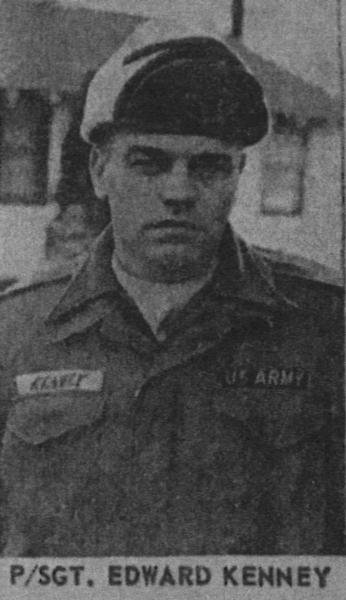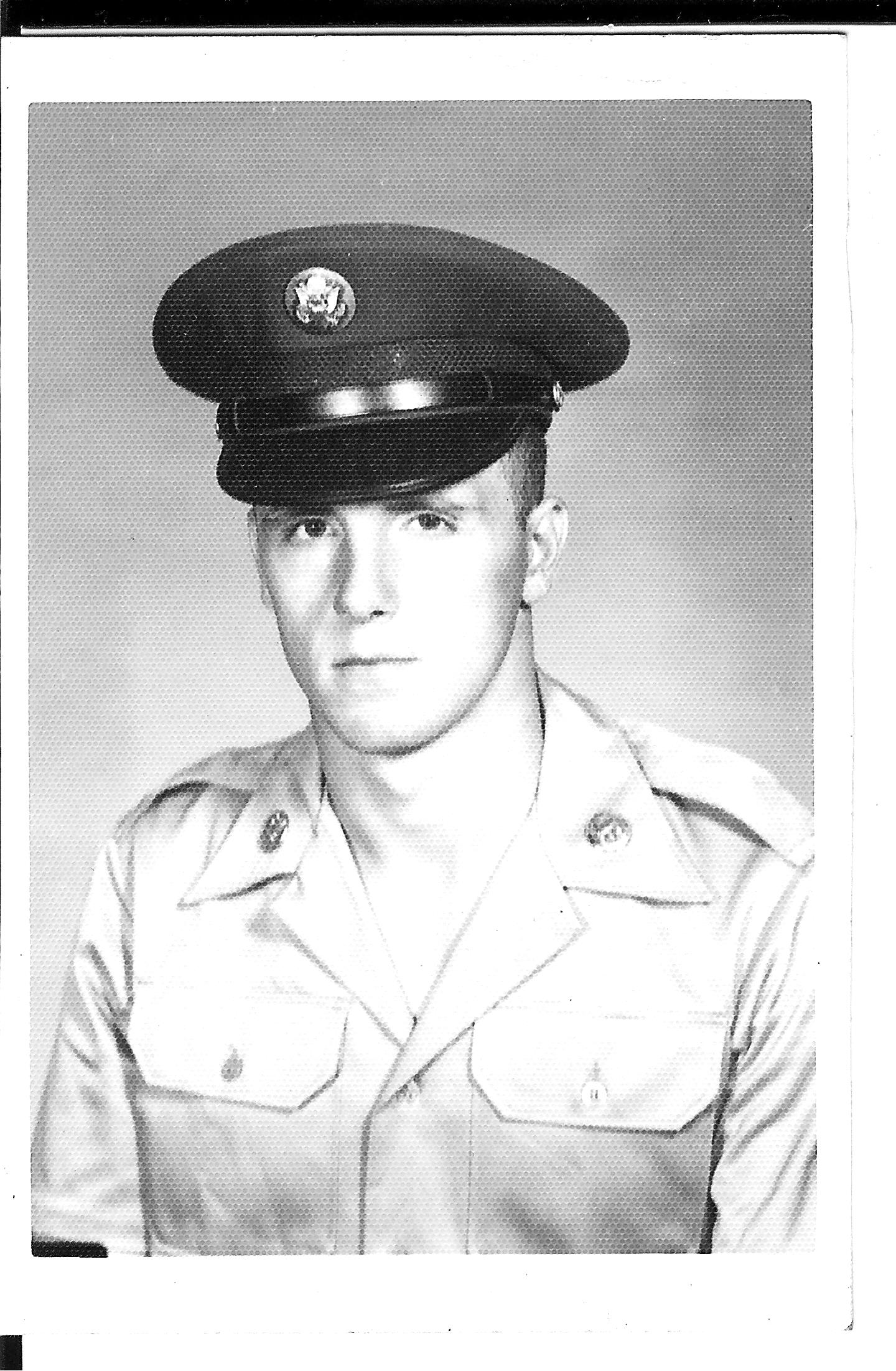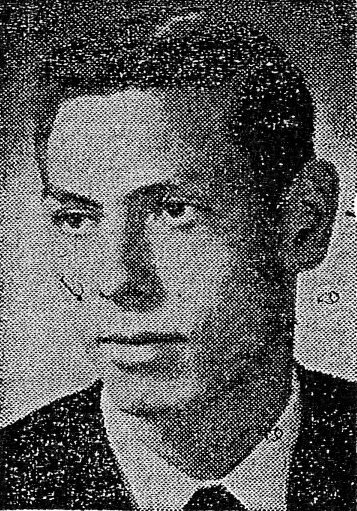
EDWARD KENNEY - SFC
- HOMETOWN:
- cliffside park
- COUNTY:
- Bergen
- DATE OF BIRTH:
- April 27, 1933
- DATE OF CASUALTY:
- May 23, 1965
- BRANCH OF SERVICE:
- Army
- RANK:
- SFC
- STATUS:
- KIA
- COUNTRY:
- South Vietnam
Biography
Edward Kenney was born on April 27, 1933. His home of record is Cliffside Park, NJ. He had one brother, John.
Kenney served in the US Army and attained the rank of Sergeant First Class (SFC). He served during the Korean War and met his future wife in Korea.
He arrived in Vietnam for his second tour of duty in November 1964 and was assigned to Military Assistance Command, Vietnam. Kenney worked as an instructor and advisor to the South Vietnamese troops.
On May 23, 1965, Kenney was killed in action while on patrol with a contingent of South Vietnamese Forces. They were attacked by a larger Viet Cong force near Toi Bin.
Kenney was survived by his mother, Florence, his wife and three children. He is buried at the Beverly National Cemetery.
Their mission (MACV) was to constantly seek to engage the enemy in combat and to provide assistance to the constitutional government of Vietnam in building a free society capable of defending itself. The 21st Infantry Division served as advisors to the South Vietnamese's 3rd Battalion, 32nd Regiment, 21st Infantry Division, Army of the Republic of Vietnam.
On May 23, 1965, at 0530, the Battalion (BN) was informed that they would go to Khai Quang outpost to resupply and reinforce the outpost by leaving one of the Companies (CO) of Battalion at the outpost. The outpost was located in An Xuyen Province, about 4 ½ miles southwest of the city of Thoi Binh.
By 0730, the only three Americans, Captain Orien Judson "Jim" Walker, Jr., Sergeant First Class Edward Kenny, and Staff Sergeant Willis Phillips had crossed the main canal west of Thoi Binh. SSGT Phillips requested permission to go with 1st CO, which was the lead company. CAPT Walker said yes, but told Phillips not to go all the way into the outpost until the main force joined up.
At 0900, Phillips was with the 1st CO, Kenney was with 3rd CO, and Walker was with Headquarters CO. The BN was now moving along the southern edge of Canal Zero.
The first shots were fired at 1230. Phillips heard something and fired about fifteen rounds. No shots were returned by the Viet Cong (VC). Everyone started kidding Phillips about his shooting. After the BN moved approximately 100 yards, more shots rang out, this time from a VC sniper. While the shots were high over their heads, Phillips returned fire anyway. None of the ARVN regulars returned fire. About 100 meters later, as 1st CO began to cross the canal, all hell broke loose. The 3rd CO, who Kenney was with, was engaged in a big firefight. The sound of M79s and automatic weapons filled the air. The best estimate was that they had tangled with one squad of VC.
At 1330, Walker told Phillips that the ARVN BN CO would enter the outpost and that he was going to go along. Kenney would stay outside his post with 3rd CO.
The first report of desertions of ARVN occurred at 1400 as 1st CO entered the outpost. ARVN troops had already packed their bags and left through the gate. The ARVN CO Commander (CMDR) went after them. The only way he was able to get them to stop was by firing shots over their heads. Some of these shots were very close to their heads. At about the same time, firing and mortars were heard in the area of Kenney's 3rd CO. Later, it was determined that the VC had fired about 10 rounds of 60 MM mortars at 3rd CO; however, no one had been hurt.
By 1530, Walker, Phillips and the ARVN BN CMDR had left the outpost to make the return trip back to Thoi Binh. Upon reaching the 3rd CO, some of the ARVN troops had already dispersed down alkong the south side of Canal Zero. The order was given to stop and Walker directed Phillips to move up front with the lead CO and spread them out. On his way up to the front, an ARVN soldier stopped him to say something. As the ARVN soldier knelt down, two shots rang out; one struck the soldier in the chest, the other shot grazed off the soldier's rifle that was lying unattended on the ground. Fragments from the rifle tore through Phillip's right thumb. By this time, Phillips and the ARVN troops were firing again but were not receiving any additional fire back from the VC. This twist of fate, which caused the CO to stop, precluded them from walking into the ambush further down the road. A medical chopper, "Dustoff", was called for the injured at 1600.
A call from Quan Long came in over the BN set at 1630 and Phillips took the call. Phillips later thought it was from Maj Owre asking if they had a message for him. Phillips told him to standby and he would get a hold of "Little Joe 3" which was Capt Walker's call sign. After some confusion about the status of the wounded soldier, it was determined that he had died. The Dustoff had been called off. About this time, shots were fired at the Advisors and ARVN troops from the direction of Canal Zero. Automatic weapons began to fire and about three to five 81 mm rounds fell around a house where the friendlies had previously eaten lunch. Some people were in back of the house while Phillips was at the east side of the house. The VC were out in the open in groups of two, walking and firing. One VC would fire while the other one would hold some sort of cover over them to hide. The VC were so close now that Phillips could make out what color shorts and shirts they were wearing. Some VC had on black shorts; others had on brown shorts. They all had brown shirts. The firefight intensified for about five minutes and the VC were dropping in large numbers. The VC were so close, and they still only walked, that hitting them was relatively easy.
During the firefight, Phillips counted approximately 50 to 60 VC. There were many more, however. Phillips ran out of ammo and went looking for, and found, Walker in the back of the house. Walker said, "where the hell is the artillery? Let's get some on the way." Dad took ammo off two people who weren't shooting. He found two others hiding in a ditch and took their ammo back to the house so that he and Walker could reload. While Phillips was reloading he heard Walker say, "where are they going? Get back here. Stop!" Walker took off running after the deserting 3rd CO. When 3rd CO saw Walker running after them, they really took off. While this was going on, Phillips checked to see what HQ CO was doing. They were falling back as well. Phillips took off after them and caught an ARVN officer and told him to tell his troops to stop. The officer said, "They don't want to fight." He was already pulling off his Lieutenant's rank. Other ARVN troops were running by while pulling off shirts and hats, throwing weapons, maps, compasses, etc.
During the desertion, every time Phillips would stop to fire, and was able to get two or three men to fire with him, they were able to stop the VC. They killed several VC this way, but after the shots were fired, the ARVN would take off running again. Phillips ran after an ARVN Ranger that he knew. The man would not stop either. He was too busy tearing off his SGT rank.
Phillips stopped to see where Walker was and saw him about 300 to 400 meters west of his position. Walker was down on one knee firing at the VC. Phillips knew it was him because of the hat he was wearing, his size, and that he was firing his carbine. Phillips looked for Kenney but could not see him. Suddenly, an 81 mm mortar landed close to Phillips and he got hit in the side of the arm and hand. Fortunately, these were small hits. Phillips fired all his ammo and started moving back. People were lying all over the place and some of them were throwing their weapons away. The recoilless rifle man dropped his weapon; two machine guns were thrown into the water. All kinds of gear were floating in the water. Each and every one of the ARVN troops that Phillips saw had a grenade out with the pin pulled. They would push him away or say "De-De" (GO!). Phillips took a fifteen round magazine off an ARVN and fired at the VC. The VC were so close that Phillips could see their faces. During close combat, he hit one in the face and the VC dropped his rifle and fell. The VC's comrade reached down to get the rifle and Phillips shot him. Every time that Phillips would fire at the VC, they would stop their advance. Phillips fired all but one round and ran back to the canal. When he got there a group of ARVN deserters were climbing out the other side. Phillips tried to stop them by pulling some of them into the water to create a sort of traffic jam. They would break free and run.
The VC now stopped coming straight at them and were flanking them. At this point in time, the jet air strike started. Phillips stated it was a real good one that saved lives because it stopped or scattered the VC. The distraction of the air strike caused some of the ARVN to stop running. Phillips was able to get about 20 of them to stop and start moving some of the wounded south. As soon as the air strike was over, the VC hit again, and the troops that Phillips had got to stop running, took off again.
Phillips only had one round left and said to himself that he would keep it to the very last. He had a knife and he was tired. He was up to his shoulders in the canal and was not going to move another damned inch! He then saw Walker's radio operator about 100 yards away. He yelled to him, "Tell those cowards that the Americans are staying and fighting, and the planes are staying and fighting. Let's all fight, fight for Vietnam." It worked. The radio operator called some of the ARVN back. Then the Professional Private (Pro Pvt) came over and managed to call some more ARVN back. About twenty ARVN troops stopped long enough to fire what they had in their weapon. Then the Vietnamese Air Force came in and conducted another air strike that again dispersed the enemy. Phillips and the ARVN fell back and put some distance between them and the VC.
Phillips asked the radio operator where Walker and Kenney were and the radio operator replied: "Broken." Phillips couldn't get out of him whether that meant dead or wounded. The radio operator then said: "BN Cmdr and Walker, broken." The radio operator said in the rear of the house, about 200 meters away. This corresponded to approximately the last time Phillips had seen Walker. The Pro Pvt indicated that he had seen Kenney dead as well as the BN Cmdr. Phillips believed that Walker couldn't stop the 3rd CO and went over to the house to help the BN Cmdr. Apparently, Kenney was also there because, it was determined later, that Kenney's body, as well as the body of the BN Cmdr, were found close to each other. The Pro Pvt then told Phillips he had seen Walker, Kenney and the BN Cmdr down. When asked later if he had seen any blood on Walker, the Pro Pvt said no. When asked the same question, the radio operator said yes and pointed to the right side of his stomach. Phillips felt that the Pro Pvt and the radio operator were the most reliable men in the entire BN, including its officers.
After approximately 1830, the mission now dealt with the extraction of the wounded, returning to a safe outpost, and avoiding further contact with the VC. The VC were now in a tree line overlooking the canal area and Phillips was able to coordinate another air strike on the enemy position to keep then subdued. Again, the ARVN troops displayed their lack of courage. When Phillips found the Dustoff choppers their makeshift Landing Zone, the uninjured ARVN troops dropped the stretchers of the wounded, and attempted to climb on the choppers.
As it was growing dark, and the weather deteriorating, a Dustoff pilot told Phillips he better get in because he didn't think he could find the LZ again. Phillips declined. He knew that if he left, the ARVN that were left would leave the wounded and desert.
Phillips and the remaining ARVN regulars humped through the jungle. It was now nightfall and they came upon a house. One of the ARVN regulars got a girl up and she lit a torch. The girl then led them to the edge of the outpost. Apparently, farmers routinely lit torches at night to move around to let both the South Vietnamese and North Vietnamese know that they were not fighters, they were farmers. It worked, because Phillips and approximately 50 RVN troops made it to a safe outpost and were later transported back to Thoi Binh.
Taken in part from a paper written by Ray C. Phillips of Parker, CO. His father, Willis E. Phillips served as part of the same MACV and made detailed accounts of the events of May 23, 1965.
Sources: Ray C. Phillips, newspaper clippings and NJVVMF, Photo from VVMF.
Remembrances
Be the first to add a remembrance for EDWARD KENNEY
Help preserve the legacy of this hero, learn about The Education Center.
LEARN MORE

